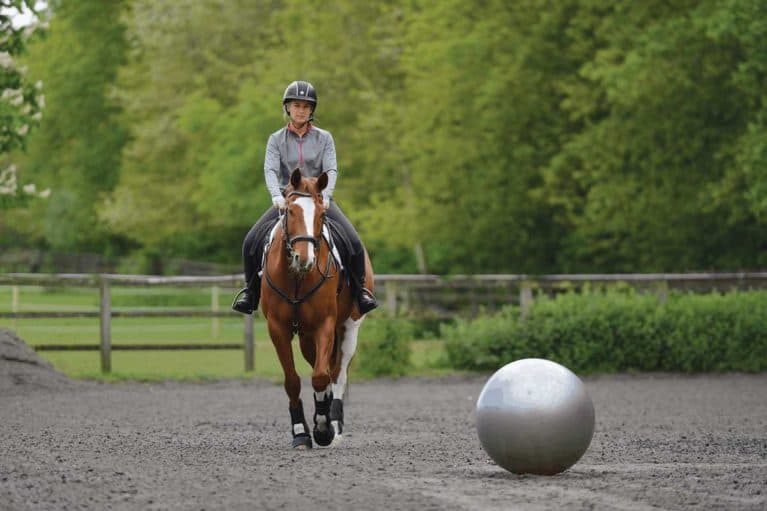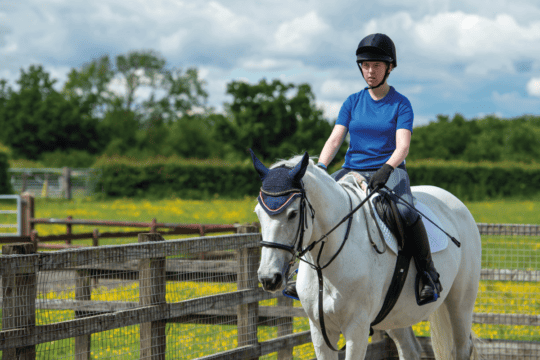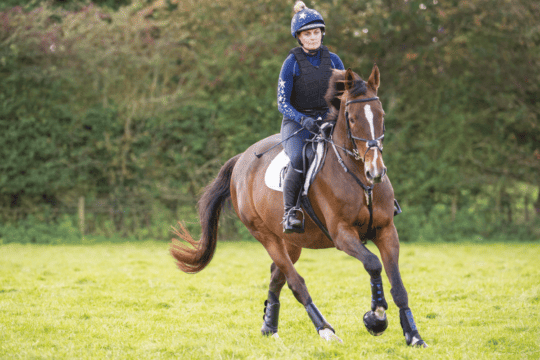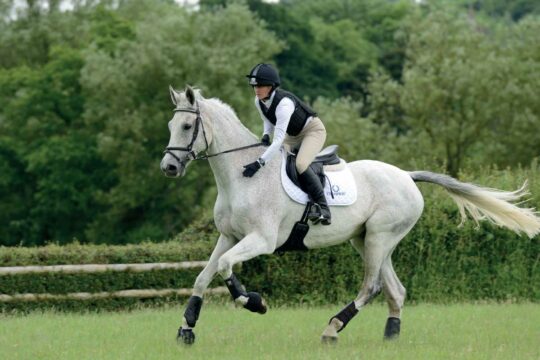Featured Professional

Anna Haines
Anna is a qualified Equine Behaviour Consultant based in Cheshire, who has been around horses for most of her life, having started riding at the age of five. She is a regular contributor to Horse&Rider and is a member of our 'Ask the Expert' team.
Whether your horse is spooky or you simply want to build his confidence in new situations, spook busting training can really help. Anna Saillet explains why

It can be frustrating dealing with a horse who repeatedly spooks at things, but it’s important to understand why he might be doing it and that there’s lots you can do to help him overcome this behaviour, and make life easier and more enjoyable for both of you.
Why horses spook
Horses are flight animals and in their natural environment, you would find them living and grazing on open plains with fellow members of their herd. They are also a prey species, which means that they must be able to escape any threat or danger rapidly. While horses do have the ability to attack a predator by biting or kicking, this is an extremely risky strategy, so instead they are much more likely to use flight to get away from the danger as quickly as they can. When your horse spooks or shies, this is a fearful response to what he perceives to be a frightening stimulus. It’s important to remember that just because it isn’t scary to you, doesn’t mean that it won’t seem very frightening through the eyes of your horse. As owners, we’re constantly asking our horses to override their natural evolutionary drive to rapidly flee from danger when we ride and work with them.
It’s true that some horses appear to be much more spooky than others and this can be due to multiple reasons. While there are some breed differences in behaviour, with certain breeds considered to be more fearful, reactive or placid than others, there are also huge individual differences in personalities within breeds, too. The bottom line is that each horse is an individual and may respond differently to any other horse in the same situation. Past experiences will also have an effect on current behavioural responses and horses who have suffered negative experiences in frightening situations may be more fearful when faced with new experiences or stimuli.
The handler or rider can also have a great influence on a horse’s behaviour. An anxious, nervous or highly strung rider is unlikely to be able to positively influence a nervous or anxious horse, because both horse and rider will be reading and responding to each other’s nervous energy and body language. If you find that you’ve become tense with your horse due to a previous bad experience when he’s spooked at something, it may be worth enlisting the help of someone else as simply trying to push through your nerves may make the situation worse rather than better. There is never any shame in asking for help and so often this is the right decision to make for both you and your horse.
As with any behavioural concern, it’s essential to always rule out pain as a possible factor if you find that your horse is very spooky. This is especially important if this is a new behaviour that your horse hasn’t previously shown – any change in behaviour should always be taken seriously and pain always ruled out by your vet before attempting any retraining.
Top Tip
- ‘Slowly, slowly wins the race’ – while there are a multitude of trainers who will try to convince you that you can successfully retrain your horse in just a couple of very short sessions, be very careful not to fall into the trap of believing this. To change behavioural patterns in any species takes time, patience and dedication. When dealing with horses who are spooky, to create a change in their behaviour you have to change their emotional response to potentially frightening stimuli and by having an understanding of the neuroscience involved in this process, we know that it’s not possible to achieve
this overnight. - It can be beneficial to have your horse’s companion nearby when introducing him to new, potentially frightening objects, as this will help to minimise his baseline stress levels. Start by walking your horse at a distance from the object, then gradually move closer to it each time you pass. Here you can see that the horse is focussed with one ear on the object and one on his rider, while she remains calm and with a loose rein. Always reassure and reward your horse when he demonstrates the behaviour that you want of calmly approaching or looking towards the object.
De-spooking the spooker
Because we know that spooking is a result of a fear response, it goes without saying that to de-spook a spooky horse you need to start your training in a calm, relaxed manner and in a location that is already familiar to him, where he is least likely to become stressed or anxious. For many horses, this may be the yard where they’re kept and often the safest place to work is the arena there. It can be very beneficial to have your horse’s companion nearby, so that he’s not socially isolated while you work through your training with him, as this will help to minimise his baseline stress levels.
When retraining a spooky horse, the aim is to increase his confidence so that he’s more able to cope in potentially frightening situations and to provide him with the confidence to remain calm. This can be done through the gradual process of desensitisation and counter-conditioning to different objects and obstacles, in a variety of locations and situations. This means that your horse is desensitised to scary-looking stimuli so that they no longer evoke a fear response, then that stimulus is repeatedly paired with something that’s emotionally positive – for example, a food reward or a wither scratch – until a positive association is created. The more weird and wonderful things that you can introduce your horse to in a controlled environment before venturing out, the better. Your imagination is the only limit to the objects and situations you can introduce him to, but you must remember to always start with simpler things until he has gained confidence. Eventually, you should build up to more frightening-looking stimuli, which may include things to go under or over, or things that flap, move or make an unusual noise. The idea is that, in a controlled environment, you introduce your horse to more bizarre things than he is ever likely to bump into when out and about. It’s really important to start small and simple, so begin with one object that’s unlikely to flap or move in a way that could startle him.
Top Tips
- Ignore the bad, reward the good is the mantra you should use when training your horse. For every glance he makes in the direction of a scary-looking object, every step towards it and every time he walks calmly past it, make sure you give him a reward. If he is a horse who enjoys a wither scratch, this is perfectly suitable to use as a reward, but be sure to check that he does actually enjoy this before you attempt to use it in any training scenario.
- Constantly observe your horse’s behaviour, particularly the subtle signs. In order to be able to do this reliably, it’s important to spend time observing his behaviour in a variety of settings so that you are confident that you can recognise when he begins to feel anxious. Observe his face particularly closely, because being able to recognise tension through his face, muzzle and nostrils, and when he begins to triangulate his eyes will give you the indication you need to go back a couple of steps in the process to ensure you don’t push him over his threshold.
- Try to work just at the edge of your horse’s comfort zone. It’s important for him to remain as calm and relaxed as possible during training, but in order to stretch his comfort zone, you need to work right on the edge of it as this is where the most learning will occur.
It’s inevitable that at times you will accidentally push your horse a little harder than you should and work through training more quickly than he is ready for. This may mean that he startles at an object, for example. If this happens, remain calm and relaxed, then go back a couple of steps in your programme to something that he found easier and start again from there, this time working more slowly and being sure to observe your horse’s subtle body language so that you can recognise if he is becoming anxious.
- initially work with him at a comfortable distance away from the object, rather than asking him to walk immediately up to it or near to it. If your horse remains calm and relaxed at a distance, gradually start to move closer and closer, ensuring that your horse remains calm and relaxed
- when you start to get closer to the object, it’s likely that you will need to pass the object more times until your horse is completely relaxed, at which point you can move a little closer again. Continue to do this until you’re close to the object
- allow him to approach it in his own time without putting pressure on him to keep moving towards it. If he wants to turn away, don’t prevent him from doing this, but instead allow him to move away, reassure him, then encourage him and reward him for approaching the object again when he’s ready.
Some horses may find it helpful to observe another, more confident horse approaching and passing the scary-looking objects, and it can also be beneficial to have another person approach and investigate the object on foot. This can help your horse realise that the object isn’t that scary after all.
The key to a successful de-spooking programme is repetition, repetition, repetition. You may need to go past each obstacle numerous times on many days and even once you’re happy that your horse is confident with a particular object, bring the same one out again after a break of several days and repeat the process. At different times, place the objects in different locations to where you did the initial training with your horse to ensure that he generalises his confidence to objects in a variety of places, not only always in the same location.
Once you’ve used various objects on their own in the home environment, start to put out multiple objects at the same time so that your horse gains confidence around many different objects at the same time. When you move on to this, be sure to go back to using the most simple objects initially and work up again to the more unusual ones once you’re happy that your horse is progressing calmly and confidently.
Once you’re happy that you’ve exhausted all possibilities of the objects that you can create in your home environment, move some of the objects to other locations outside the yard. Don’t be surprised if your horse becomes worried about passing an object out on a hack that he has been happily walking past at home. This is completely normal and should be expected, as horses are not typically very good at generalising what they’ve learnt in one location to another location. Stick with the same process and follow the same principles as you did at home – at first work him at a distance that he is comfortable with from the object and gradually move closer to it while also providing him with reassurance. Make sure that you never get angry with him as this will make him anxious and could very easily make him fearful of the object you’re trying to make him more confident with.
Spook-busting kit
Almost every yard has numerous items lying around that can be very handy for helping with your de-spooking programme. Things such as jump wings, poles, fillers, flags, bunting, tarpaulin, yard equipment and balloons can all be put to good use – the more imaginative you are, the better. When your horse starts to become really confident with walking past scary objects, you can also begin to include obstacles for him to walk over, under and through to really develop his confidence for almost every eventuality.
Don’t flood him
Some people advocate the use of methods such a tying a tarpaulin to the horse’s tail in an attempt to de-spook him, but these methods are seriously detrimental to the horse’s welfare and should never be attempted as they are very likely to make the problem worse rather than better. This type of training is called flooding and means that the horse is repeatedly or constantly exposed to an extremely frightening stimulus and not given the opportunity of escape. This can cause extreme fear responses and could result in serious injury to both you and your horse. Further more, your horse is likely to learn that the frightening stimulus (the tarpaulin) is indeed a rather terrifying thing to be anywhere near, making his fear response even stronger. It’s also possible that your horse could then generalise this fear response to other things that may either look, smell or sound like the tarpaulin, making him more spooky than he ever was in the first place.







